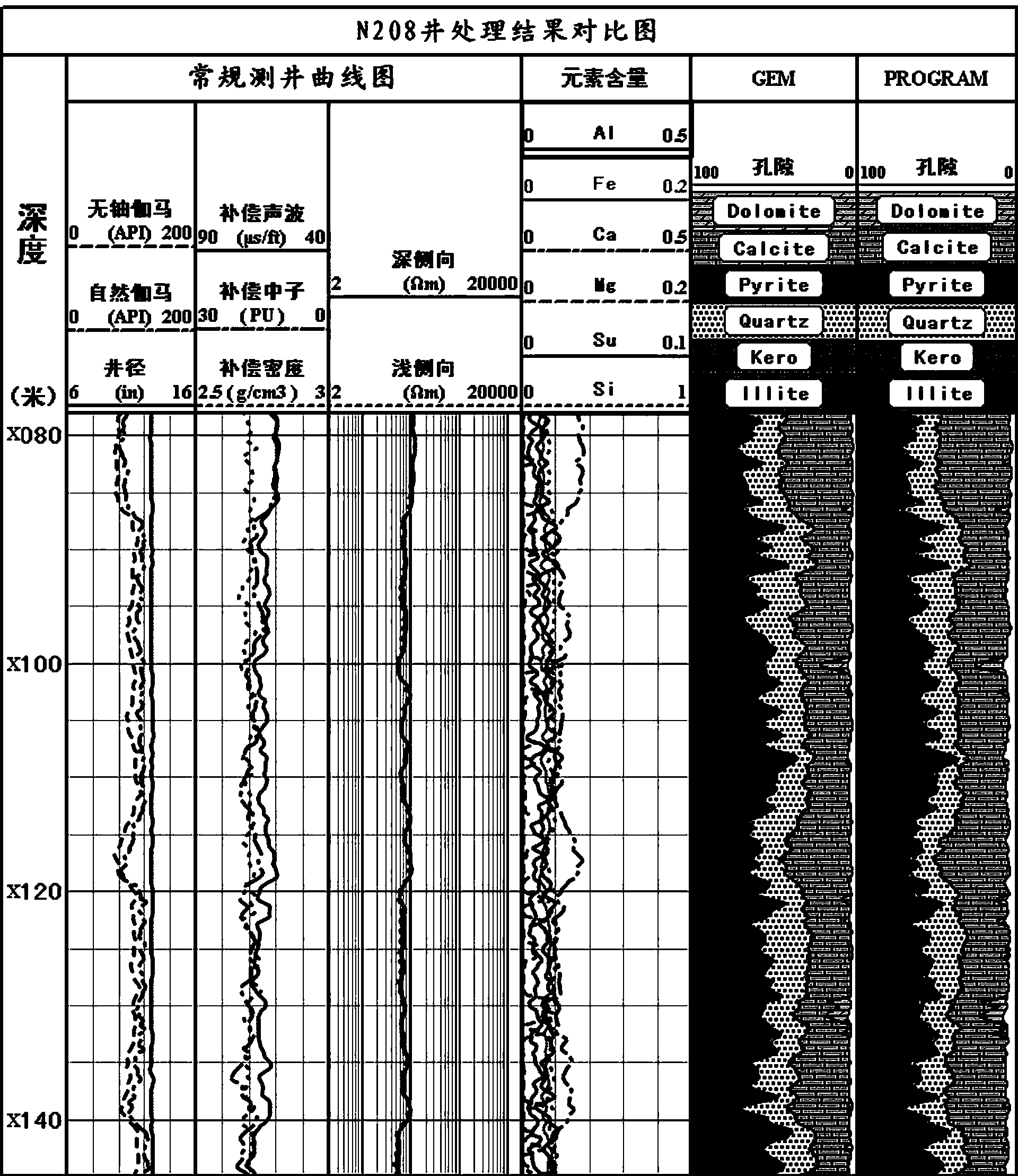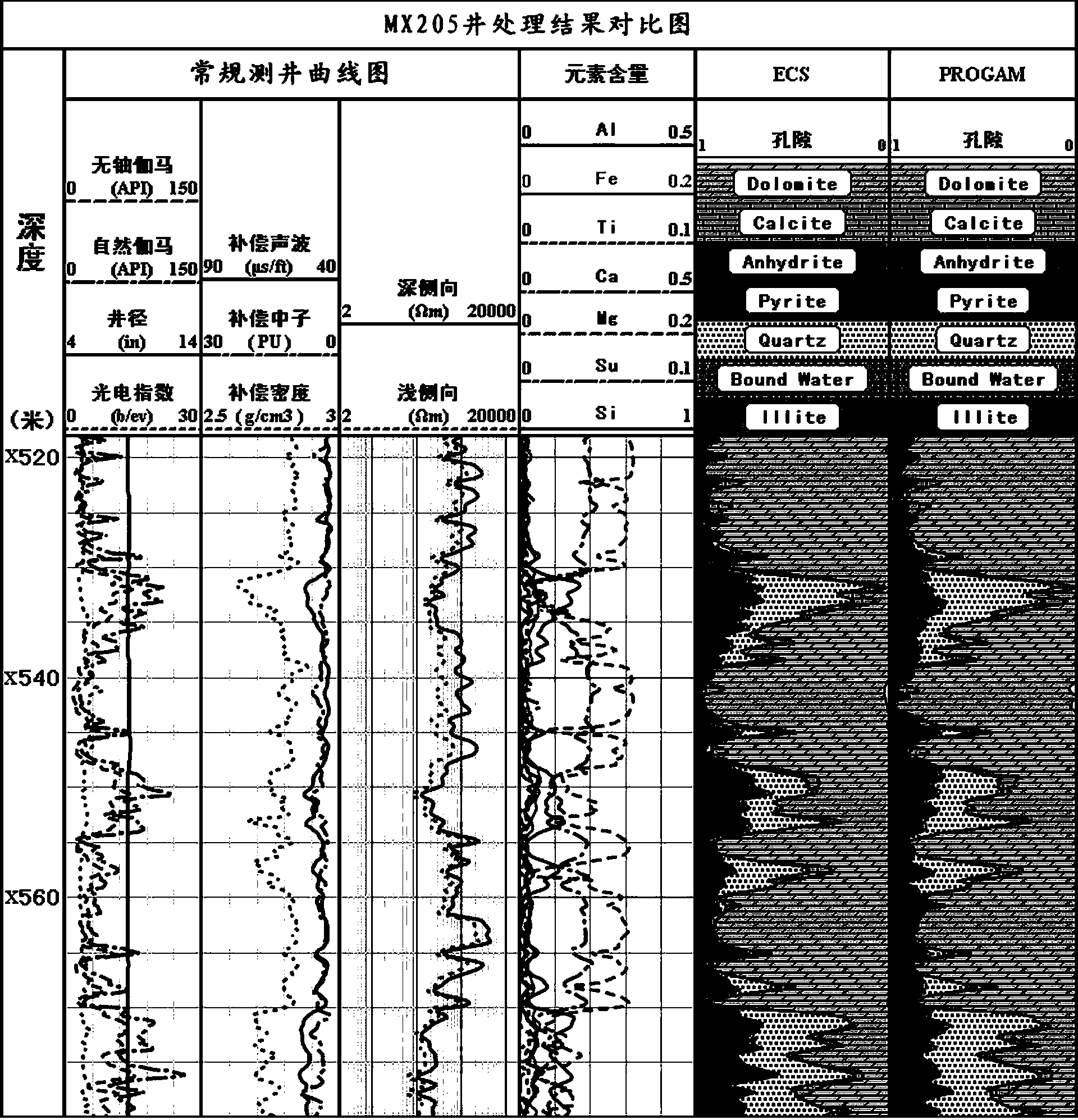Method of calculating mineral components of rock in formations through element contents
A technology of mineral composition and element content, which is applied in calculation, earthwork drilling, special data processing applications, etc., can solve the problems of insufficient logging data, usage restrictions, lack of element content data, etc., so as to improve calculation accuracy and improve accuracy. The effect of high performance and fast calculation speed
- Summary
- Abstract
- Description
- Claims
- Application Information
AI Technical Summary
Problems solved by technology
Method used
Image
Examples
Embodiment 1
[0032] A method for calculating the volume content of formation rock mineral components by element content, comprising: taking the formation element content curve and conventional well logging curve obtained from element logging as input information, combined with regional geological parameters, and calculating the complex lithology formation rock Volume content of mineral components.
[0033] Described method specifically comprises the following steps:
[0034] a. The rock space of the strata consists of minerals and pores, and the volume model of the logging response to the rock space is:
[0035] ( i=1,2,...m ) (1)
[0036] In formula (1): A is the coefficient matrix, that is, the mineral composition logging skeleton response value; B is the logging value, that is, the response value of the formation to the logging instrument; X is the volume to be solved, that is, the mineral composition of the formation rock; m is the number of logging items, n is the numbe...
Embodiment 2
[0049] Solve the problem of how to convert the formation element content obtained from well logging into the formation rock mineral volume content, and obtain the formation rock mineral composition.
[0050] The technical scheme that solves its technical problem is briefly described as follows:
[0051] The rock space of the formation is composed of minerals and pores, and the minerals are generally composed of quartz, feldspar, calcite, dolomite, pyrite, organic matter (kerogen), gypsum, coal, illite, chlorite, montmorillonite, etc. . The volume model for the log response to the rock space is:
[0052] ( i=1,2,...m ) (1)
[0053] In formula (1): A is the coefficient matrix, which is the response value of the mineral composition logging framework; B is the logging value, that is, the response value of the formation to the logging instrument; X is the volume to be solved, that is, the mineral composition of the formation rock; m is the number of logging items, a...
Embodiment 3
[0078] Through the calculation method of the present invention, the formation rock mineral composition such as figure 1 , figure 2 shown. figure 1 Among them, the first track is the depth, the second, third, and fourth track are conventional logging curves, and the element content of the fifth track is Al, Fe, Ca, Mg, Su, and Si are aluminum, iron, calcium, magnesium, sulfur, The weight content of silicon element, the sixth GEM is the mineral component content processed by Halliburton software, the seventh PROGRAM is the mineral component content result calculated by the present invention, Dolomite is the volume of dolomite, Calcite is the volume of calcite, and Pyrite is the volume of calcite. Pyrite volume, Quartz is the volume of quartz, Kero is the volume of kerogen, and Illite is the volume of illite.
[0079] figure 2 Among them, the first track is the depth, the second, third, and fourth track are conventional logging curves, and the element content of the fifth ...
PUM
 Login to View More
Login to View More Abstract
Description
Claims
Application Information
 Login to View More
Login to View More - R&D
- Intellectual Property
- Life Sciences
- Materials
- Tech Scout
- Unparalleled Data Quality
- Higher Quality Content
- 60% Fewer Hallucinations
Browse by: Latest US Patents, China's latest patents, Technical Efficacy Thesaurus, Application Domain, Technology Topic, Popular Technical Reports.
© 2025 PatSnap. All rights reserved.Legal|Privacy policy|Modern Slavery Act Transparency Statement|Sitemap|About US| Contact US: help@patsnap.com



